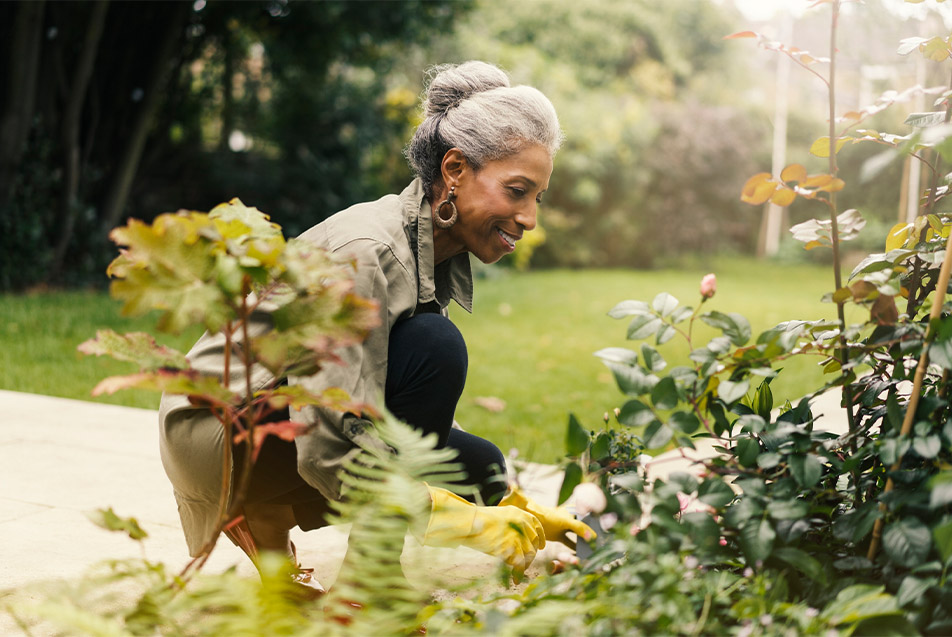
As the weather continues to warm, many escape to the great outdoors, rolling up their sleeves and digging into their yards and gardens. While gardening boasts many rewards, it goes hand-in-hand with aches, pains and injuries. In honor of National Gardening Day, we turn to Camille Schuelke, a greenhouse farmer at the Parkview Community Greenhouse, to share her favorite tips for a pleasant and pain-free gardening experience this year.
Common gardening injuries
Gardening is an excellent choice if you want to get some physical activity while also beautifying your home or neighborhood. It can be a fun and therapeutic activity but also hard on the body. Both devoted and beginning gardeners tend to suffer common gardening injuries such as neck pain, shoulder pain, lower back pain, cuts and scrapes, sunburns and dehydration. So, before you take to the yard, let’s explore some preventative measures and helpful tips.
Things to remember before, during and after gardening
Before
Warming up and stretching are essential exercises that will help get your blood flowing before beginning any gardening activities. Additionally, it’s best to avoid caffeine and heavy foods. Instead, eat a light yet filling meal to give you energy. Also, be sure to prepare and bring a drinking container with you as you work.
During
Use your legs more. Move up and down instead of bending and twisting your back. Try to find a way to elevate your garden by utilizing a taller raised bed or grow bags. If elevating your garden isn’t possible, gardening knee pads and incorporating stools with wheels may be helpful, allowing you to sit while you work. It’s important to remember that if it hurts or is uncomfortable, stop what you are doing. You may need to change positions or take a break and stretch.
After
It’s essential to stretch and cool down after working in the garden, just as you would after any physical activity. This will help protect your body from pain, injury and cramping while loosening your muscles before stopping for the day.
Additional tips for avoiding injury
A few other items you should also consider and that will help prevent injury while fostering healthy gardening practices include:
- Safe lifting: Proper technique when lifting is crucial. The best way to lift anything when gardening is to use your legs and gluteal muscles while facing forward and keeping your back and neck straight. Do not twist. Then, when ready, dig in with your heels and lift.
- Aches, pains and strains: To minimize these ailments, only do what you are comfortable with and in a time frame you can handle. Don’t be afraid to ask for help and take breaks as often as needed. Use a high workbench or surface during gardening prep to limit the time you bend your neck and back.
- Sun exposure: The best time to garden is in the morning or at dusk since the sun hasn’t fully risen or is starting to set and temperatures tend to be cooler. Believe it or not, this time of day is better when working with plants too. It will help minimize transplant shock or stress from heat and direct sunlight. Also, all gardeners should wear sunscreen, loose, light-colored clothing, and a large-brimmed hat to help prevent sunburn and limit sun exposure.
- Take breaks: It’s important to take frequent breaks when gardening. A good rule of thumb is to stop and smell the roses every half hour or so. These recesses not only give you a chance to step back and enjoy your work but also allow you to take a moment to stand up, stretch, walk around and get some water. Break-taking also provides a chance for you to rest in the shade and cool down, preventing heat exhaustion.
- Hydration: Staying hydrated is essential when working outside. It’s extremely easy to get dehydrated and not realize it. Water or drinks containing electrolytes and sodium are a must when gardening. Drinking 10 ounces of water every half an hour is a good start. Also, avoiding caffeine both before and during yard work is essential. Many caffeinated drinks will dehydrate the body and starting any physical activity off well hydrated is vital.
- Protective gear: Gloves are one of the most valuable items when gardening. They help protect your hands from cuts and scrapes when using sharp tools or digging in the dirt. According to the United States National Library of Medicine, wearing gloves while gardening will also help reduce the risk of contracting soil pathogens such as tetanus and botulism. These soil pathogens can cause life-threatening infections. Additionally, people with compromised immune systems should use a face covering to prevent inhalation when tilling or when soil is being blown around.
More information
Please visit the Community Greenhouse and Learning Kitchen events page to learn more about the available classes and tours.



